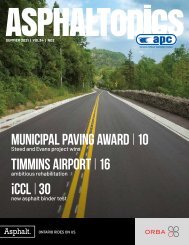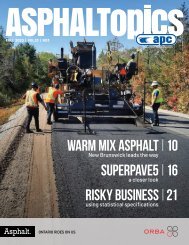ASPHALTopics | Summer 2020 | VOL 33 | NO 2
ASPHALTopics is the official publication of the Ontario Asphalt Pavement Council - A Council of the Ontario Road Builders' Association. Articles within ASPHALTopics may not be republished without express permission from OAPC.
ASPHALTopics is the official publication of the Ontario Asphalt Pavement Council - A Council of the Ontario Road Builders' Association. Articles within ASPHALTopics may not be republished without express permission from OAPC.
- No tags were found...
Create successful ePaper yourself
Turn your PDF publications into a flip-book with our unique Google optimized e-Paper software.
Mixes with insufficient AC content are unable to hold
the aggregates together, lack cohesion and, through a
combination of traffic and temperature changes, are prone
to premature cracking. All the mixtures examined in the
Quality of Asphalt Review had asphalt content values ranging
between 4.5 and 5 per cent. For a cold climate like Ontario,
the report expects to see asphalt contents of 0.5 to 1 per cent
higher at least.
Some suggested options to address the issues with designing
asphalt mixtures for improved durability include:
• specifying a higher minimum AC content;
Studies have shown that mixes with higher AC content
outperform those with lower AC content. Higher AC content
is largely driven by increasing the minimum requirements
for Voids in the Mineral Aggregate (VMA) during design and/
or production. Since the VMA available is controlled by the
aggregate properties, blend gradation, mixture viscosity and
the compactive effort, a key to achieving the correct increase
in AC content is to ensure the correct aggregate bulk specific
gravity (Gsb) is used in the mix design and during production.
• lowering the Laboratory Compaction Effort (number
of gyrations);
Reducing the Ndesign requirement by 20 to 25 per cent depending
on the design traffic is a proven strategy to obtain more AC in
the mix, and has resulted in increased density in the field.
• lowering the air void content of the mix to allow
more asphalt;
In this case, the design aggregate structure is selected based
on 4 per cent air voids, but the final design AC content for that
structure is selected at 3 per cent air voids by using the air void
regression technique. This option is being evaluated in Ontario
with recent modifications to BITU0025 (SP 103F03M) and
BITU0026 (SP 111F06M).
• introducing cracking testing on the asphalt mixes prior
to finalizing a mix design; and
This consists of designing the mix for intended application
and service requirements then running performance tests on
appropriately conditioned specimens that address multiple
modes of distress taking into consideration mix aging, traffic,
climate and location within the pavement structure. Some
states such as Texas, Louisiana, California, New Jersey and
Illinois have incorporated cracking and rutting tests into their
specifications. Efforts are being made in Ontario towards
better understanding of this option.
• the Superpave 5 Volumetric Mix Design Method.
This method requires that mixtures are designed to have the
same density in the lab and in the field. Optimum binder content
is chosen at 5 per cent air voids rather than the currently
specified 4 per cent, thus decreasing the in-place air voids
target from 7 to 8 per cent down to 5 per cent. To maintain
the same volume of effective asphalt content, the minimum
VMA requirement is increased by 1 per cent, and the design
compactive effort is decreased to 50 gyrations. Ontario’s
experience with this method is limited.
In summary, increasing the AC content
in asphalt concrete mixtures should be
a high priority for improving pavement
performance in Ontario. This can
be encouraged by increasing the
minimum VMA requirement, lowering
the Ndesign requirements to increase inplace
pavement density, exploring the
air void regression mix design method,
implementing mixture performance
tests for “Balanced Mix Design” and
quality assurance, or by advancing
the Superpave 5 mix design system.
Regardless of the method adopted,
differences between the desired
properties of the Job-Mix Formula
(JMF) and the properties of the
plant-produced asphalt mix MUST be
checked and verified for compliance,
and necessary adjustments should be
made to minimize any variations and
mitigate against consequent negative
effects on the in-service pavement
performance.
42 OAPC | ASPHALTOPICS


















